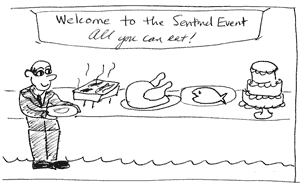At staff meetings, how should we communicate with laboratory staff about an error that harmed a patient?
 Respondent
Respondent
Michael Astion, MD, PhD
Chair of the Patient Safety Focus Editorial Board
This answer is as clearly as possible. Managers commonly make two errors when communicating about such events. The first and most common is avoidance. There are many forms of avoidance, but the worst is not communicating at all. Another popular form involves using euphemisms or words meant to obscure the true meaning. At the other end of the spectrum, another common communication error is hysteria. Between the extremes of avoidance and hysteria, lies the middle ground, clarity, which is what lab leaders should strive for.
Let's look at a hypothetical case to illustrate these two communication errors.
The Case
A delay in communicating an unexpected, critically high INR result led to prolonged bleeding in a hospitalized patient and the need to transfuse an extra unit of packed red blood cells. The patient did not suffer permanent or long-term harm. This communication error was traced to a number of causes, including a physician who was delayed in calling back the lab because of a pager problem and a lab tech who was delayed in calling the result because she was handling multiple, concurrent critical results.
Here are examples of two lab managers communicating these events.
The Avoidance Communication
"Last night, we had a variance in the lab that led to an adverse event. We are filling out an occurrence report, and then I am going to an all-day training."
The Hysterical Communication
"A patient almost bled to death because we were so late in calling that critical result. I can't stand working here. We're way too busy! Nothing works. The physicians don't call back! They're all idiots. I'm going to buy that bed and breakfast and get the heck out of here."

To resolve and eliminate errors, lab leaders should explain
problems using clear language without euphemisms.
Why Clear Communication Works
Instead of not telling staff about a patient harm error or ranting hysterically about it, lab managers should simply relate the case in the way it is described above. To achieve this, use a modest amount of thoughtfulness and common sense language that nearly all people can understand.
The problem with avoidance is that it lowers or removes the urgency for quality improvement. Telling staff that errors in the blood gas service are prolonging patient time on ventilators will send staff into quality improvement overdrive. On the other hand, telling staff that variances are leading to potential adverse events will make them leave the lab in frustration.
Bad Word Habits
Medical euphemisms deserve special attention (See Table). Using euphemisms to describe medical errors that harm patients represents a normalization of deviance in healthcare communication, a common occurrence in clinical labs today (1). For example, results of online competency assessment exams about patient safety administered to a national lab audience by Medical Training Solutions demonstrated that about 30% of lab workers prefer euphemisms to clear communication when describing lab errors that harm patients. This increasing reliance on euphemisms to describe medical harm is likely rooted in the desire to avoid painful, complex quality improvement issues, as well as the mountain of work they create.
|
Popular Medical Euphemisms
|
|
Euphemism
|
What it means
|
|
Adverse Event
|
A patient was harmed due to a problem in medical care. |
|
Potential Adverse Event
|
A patient was nearly harmed due to a problem in medical care. |
|
Sentinel Event
|
A patient died or was severely harmed due to a problem in medical care, most likely a preventable error. |
|
Occurrence
|
An event that has come into being. |
|
Incident
|
An event has come into being and is not good. |
|
Variance
|
A movement away from our desired norm. |
|
Near Miss
|
A patient was nearly harmed. A more accurate euphemism would be near hit. |
Popular Medical Euphemisms
These descriptions are frequently used today to describe cases where medical errors have harmed or nearly harmed patients.
Euphemisms are a bad habit—no different than swearing, smoking, spitting, and overindulgence of all kinds. Eliminating them requires what I call the bad habit toolkit. What's in this toolkit? Every possible technique ever used to improve will power. For example, have lab leaders put a dollar into a charity jar every time they or staff uses a medical euphemism to describe an error that could harm a patient. Throw a pizza party if lab management and staff go 5 days without using a medical euphemism. Use visual techniques to stop the behavior, such as responding to hospital and lab leaders who use medical euphemisms as if they are smoking in the lab.
Clarity of communication is directly related to the urgency for quality improvement, so take the time to communicate clearly to ensure patient safety.

Illustration by a Seattle artist asked to draw a hospital sentinel event
without being given the definition of this medical euphemism.
Person on left is a retiring hospital administrator
being honored for 30 years of service.
REFERENCE
1. Appold K, Astion M. Normalization of Deviance. CLN 2011;37(7).